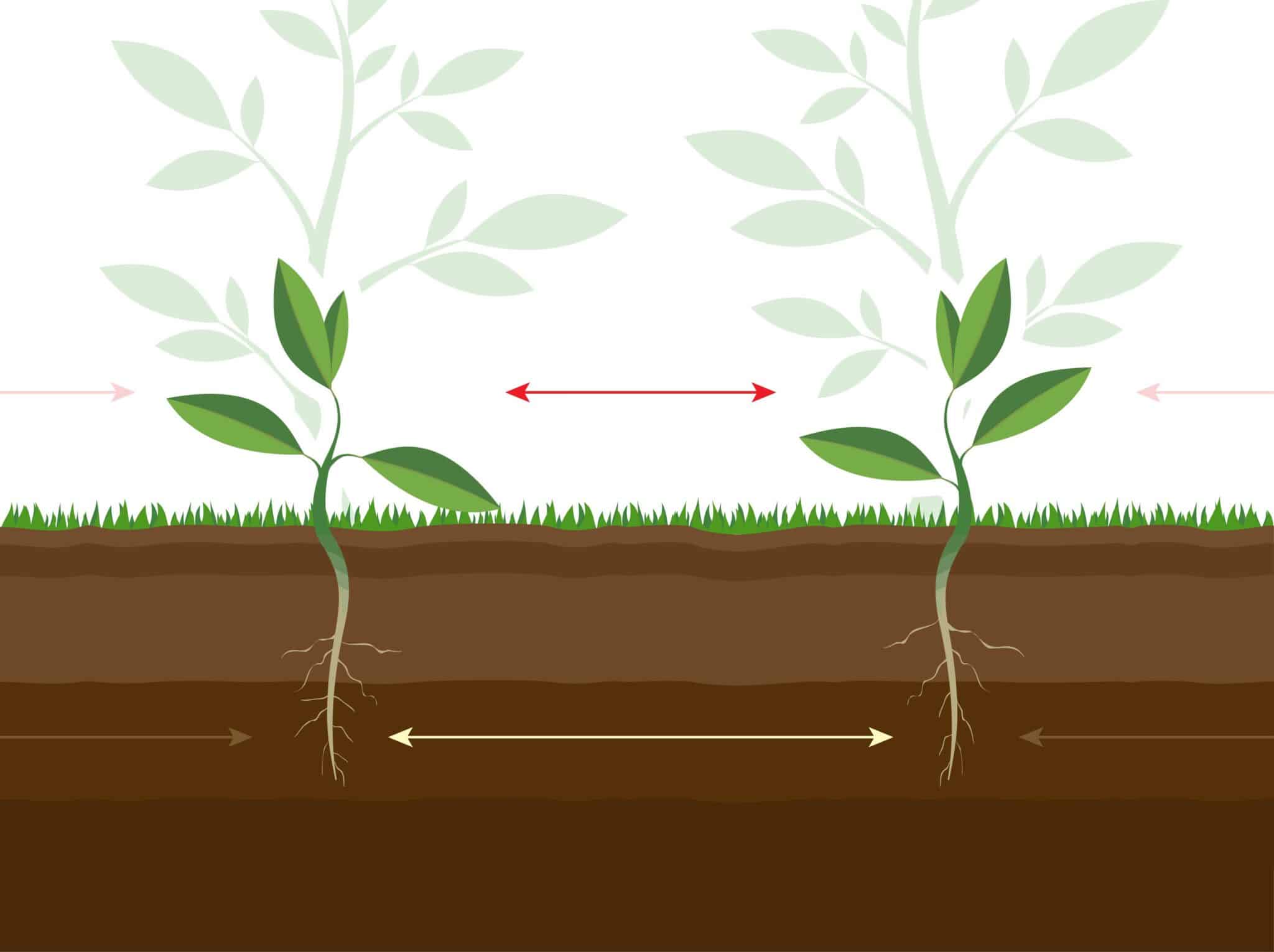In the lush landscapes of Hawaii, particularly in areas like Honolulu and Kahala, the health of a garden significantly depends on various factors, one of which is proper tree spacing. This essential practice not only enhances the aesthetic appeal of your outdoor space but also plays a crucial role in the vitality of the trees. By understanding and implementing correct tree spacing, homeowners can ensure that each tree has enough room to thrive without competing for resources.
Correct tree spacing is vital for preventing the spread of diseases, which can easily transfer from one tree to another when planted too closely. It also facilitates better airflow, which is crucial in Hawaii’s humid climate, helping to keep the foliage dry and less susceptible to fungal infections. Moreover, adequate space between trees allows for sufficient sunlight exposure, which is essential for the photosynthesis process that drives healthy growth.
Overcrowded gardens often struggle with stunted growth and poor health as trees battle for sunlight, water, and nutrients. In contrast, well-spaced trees can grow stronger and healthier, with robust root systems and better structural integrity. This not only makes the garden more resilient to environmental stresses but also enhances its overall functionality and beauty.
For homeowners in Hawaii looking to create a balanced and thriving landscape, considering tree spacing during the planning and planting stages is crucial. This practice will not only help in developing a more harmonious and visually appealing garden but will also contribute to the long-term sustainability of the landscape. By prioritizing proper tree spacing, gardeners can enjoy the full benefits of their green space, ensuring it remains a vibrant part of their home for years to come.
The Importance of Tree Spacing in Hawaii’s Unique Climate
Hawaii’s unique climate poses specific challenges and opportunities for gardeners, especially when it comes to tree spacing. The islands’ warm temperatures and high humidity levels can accelerate plant growth but also increase the likelihood of plant diseases. Proper tree spacing is essential in such an environment, as it ensures that each tree receives ample sunlight and air circulation, reducing the risk of disease spread. This practice is particularly important in cities like Kahala, where dense foliage can quickly become a breeding ground for fungal infections if not properly managed.
In Honolulu, the benefits of adequate tree spacing extend beyond health and disease prevention. It also impacts the structural stability of trees during the frequent storms and high winds that can occur in this region. When trees are given enough space, their roots can spread and anchor more effectively, providing stability and resilience against the elements. This spacing also allows for easier maintenance and access, which is crucial for regular care and inspection, ensuring that any signs of distress are addressed promptly.
Moreover, tree spacing plays a crucial role in the aesthetic and ecological balance of a garden. Well-spaced trees create a visually pleasing landscape that can enhance property values and contribute to the overall well-being of the neighborhood. They also support local wildlife, providing birds and insects with healthy habitats and food sources. This ecological consideration is vital for maintaining the natural beauty and biodiversity of Hawaii’s gardens.
To summarize, the importance of tree spacing in Hawaii cannot be overstated. It is a critical factor that influences not only the health and growth of individual trees but also the overall ecosystem of a garden. Whether in Kahala or Honolulu, gardeners must consider this crucial aspect when planning and maintaining their landscapes to ensure a thriving, resilient, and beautiful garden environment. This strategic approach to gardening not only beautifies the area but also promotes a healthier, more sustainable landscape for future generations.
How Tree Spacing Influences Plant Health and Growth
Proper tree spacing is crucial for optimizing plant health and growth, particularly in lush environments like those found in Honolulu and Kahala. When trees are spaced correctly, they have better access to the resources they need to thrive, such as sunlight, water, and essential nutrients. This spacing prevents the roots from becoming entangled, which can stress the plants and lead to poor health. Furthermore, adequate space between trees means that each can develop a robust root system, which is essential for nutrient uptake and overall tree vitality.
The benefits of tree spacing extend to disease prevention as well. Diseases often spread more rapidly among trees that are too close together, as the proximity allows pathogens to transfer easily from one tree to another. By maintaining proper tree spacing, gardeners can significantly reduce the risk of such issues. This is particularly important in areas like Kahala, where the dense foliage common in gardens can create environments that are conducive to the spread of disease if not properly managed.
In addition to health benefits, correct tree spacing also influences the growth patterns of trees. Trees that are given enough room to grow without competition tend to develop stronger, more structured branches and trunks. This not only contributes to the overall aesthetics of the garden but also enhances the structural integrity of each tree. Stronger trees are less likely to succumb to the stress from environmental factors such as high winds, which are common in places like Honolulu.
Overall, the strategic practice of tree spacing is integral to developing a healthy, vibrant, and sustainable garden. By understanding and implementing these spacing strategies, homeowners can ensure that their trees not only survive but thrive. This approach not only makes the garden a more pleasing and functional space but also contributes to the broader ecological health of the area, supporting a diverse range of wildlife and plant species.
Preventing Disease Through Strategic Tree Spacing
Preventing disease in your garden is a primary benefit of maintaining proper tree spacing. In areas like Kahala, where lush greenery is abundant, the risk of disease can escalate if trees are planted too closely. Strategic tree spacing allows air to circulate freely between the trees, reducing the humidity around the foliage that often leads to disease. This practice is crucial for minimizing the presence of moisture that can foster the growth of harmful fungi and bacteria.
In Honolulu, gardeners are particularly vigilant about tree spacing as a means of disease control. By giving each tree enough space, they ensure that not only does air circulate adequately, but sunlight can also reach the leaves and branches effectively. This sunlight exposure is vital for drying dew and rainwater, which might otherwise promote the growth of disease-causing pathogens. The result is a healthier garden where trees are less likely to encounter diseases that can spread rapidly in denser settings.
Furthermore, proper tree spacing helps in early detection and management of plant diseases. When trees are not overcrowded, it’s easier for gardeners to inspect each tree thoroughly for signs of illness. Early detection means that treatments can be applied more effectively, preventing the spread of disease to healthy parts of the garden. This proactive approach saves time and resources in managing garden health and maintains the aesthetic value of the landscape.
Overall, strategic tree spacing is not just about growth and aesthetics, it’s a critical component in disease prevention. Implementing this practice ensures that each tree in your garden has the best chance to thrive, free from the threats posed by common garden diseases. This not only enhances the longevity and beauty of your garden but also contributes to a healthier environment for the community. By embracing these spacing strategies, gardeners can enjoy lush, vibrant landscapes that are as healthy as they are beautiful.
The Role of Airflow in Preventing Garden Illnesses
Airflow plays a pivotal role in maintaining the health of gardens, especially in areas with dense vegetation like Kahala and Honolulu. Proper tree spacing significantly enhances airflow, which is crucial in preventing the buildup of moisture that can lead to garden illnesses. When trees are spaced appropriately, air can circulate freely around and between the plants, drying out moisture that might otherwise create a hospitable environment for pathogens. This natural ventilation is essential in maintaining a dry and disease-free garden.
In addition to reducing moisture, increased airflow from adequate tree spacing helps in regulating the temperature within the garden. Cooler air can move more freely, which is particularly beneficial during Hawaii’s warmer months. This not only makes the garden more comfortable for both plants and people but also reduces the stress on plants that can result from excessive heat. By keeping the garden cooler and drier, gardeners can thwart the growth of heat-loving fungi and other harmful organisms.
Furthermore, when airflow is optimized by proper tree spacing, plants are less likely to suffer from mildew and other air-borne diseases. These issues often plague gardens that are too densely packed, where air stagnates and humidity remains high. In contrast, well-spaced trees receive more wind, which naturally helps to keep the foliage dry and less susceptible to infections. This is particularly important in Honolulu, where the climate can encourage rapid fungal growth if conditions are left unchecked.
Ultimately, the role of airflow in preventing garden illnesses cannot be overstated. By adhering to guidelines on tree spacing, gardeners can significantly enhance the health and longevity of their landscapes. This practice not only supports a garden’s aesthetic and structural integrity but also promotes a healthier, more resilient ecosystem. Gardeners who prioritize good airflow through strategic tree spacing are investing in the future vitality and beauty of their outdoor spaces.
Risks and Consequences of Tree Overcrowding
Tree overcrowding can significantly undermine the health and aesthetics of a garden, particularly in areas like Kahala, where lush landscapes are common. When trees are planted too close together, they compete fiercely for sunlight, water, and essential nutrients. This competition can lead to weaker trees that are more susceptible to stress and less capable of reaching their full potential. Additionally, overcrowded trees often exhibit stunted growth and diminished foliage, which can detract from the overall beauty and balance of a garden.
In Honolulu, the risks associated with tree overcrowding extend beyond mere aesthetic concerns. Dense planting can restrict the root space available to each tree, leading to underdeveloped root systems. A compromised root system not only affects a tree’s ability to absorb nutrients but also reduces its stability, making it more vulnerable to toppling during high winds or storms. This poses a safety risk to both people and property and can lead to costly damages and necessary removal of affected trees.
Furthermore, tree overcrowding can create a conducive environment for the spread of pests and diseases. When trees are too close, it’s easier for pests to migrate and for diseases to spread from one tree to another. This can result in widespread infestations and infections, which are more difficult and expensive to manage. The lack of proper tree spacing often necessitates more chemical interventions, such as pesticides and fungicides, which can have long-term negative impacts on the environment.
Ultimately, understanding and implementing proper tree spacing is crucial for maintaining a healthy and sustainable garden. By avoiding the pitfalls of tree overcrowding, gardeners in Hawaii can ensure that their landscapes are not only visually pleasing but also ecologically sound and safe. Taking the time to plan and space trees correctly can lead to a thriving garden that enhances the local ecosystem and provides enjoyment for years to come.
Tree Spacing Guidelines for Different Tree Types
When considering tree spacing guidelines, it’s essential to recognize that different tree types have varying space requirements. Broadly speaking, larger trees with expansive canopies need more room than smaller, more compact varieties. For instance, large shade trees like the monkeypod require significant space to accommodate their wide-reaching roots and branches. This ensures they receive adequate sunlight and nutrients without overshadowing or encroaching on their neighbors. Conversely, smaller fruit trees, such as papaya, can be spaced closer together since their root systems and canopy spread are less extensive.
In Honolulu, where residential and public spaces might be limited, selecting the right tree type and understanding its specific spacing needs are crucial. This helps in maximizing the aesthetic and health benefits of each tree. For example, urban planners and homeowners may opt for medium-sized trees like the hibiscus, which provides beauty and shade while fitting well into smaller garden spaces. Proper tree spacing in such environments prevents the common issues of overcrowded gardens, ensuring each tree has enough room to thrive.
Meanwhile, in Kahala’s more spacious settings, larger trees can be used to create lush, shaded areas without the risk of overcrowding. Here, the spacing guidelines are particularly important for maintaining the health of large native trees, such as koa, which play a significant role in the local ecosystem. By adhering to recommended spacing, these trees can grow to their full potential, offering not only environmental benefits but also enhancing property values and the overall charm of the area.
In conclusion, understanding and implementing appropriate tree spacing guidelines according to tree types is essential for creating healthy, sustainable, and visually appealing landscapes. Whether in the tight urban confines of Honolulu or the expansive estates of Kahala, proper tree spacing is key to achieving a balanced and thriving garden. Homeowners and garden planners should consider both the growth characteristics and environmental impact of their chosen tree types to ensure optimal spacing, contributing to the garden’s long-term success and sustainability.
Techniques for Measuring and Planning Tree Spacing
Measuring and planning tree spacing accurately is crucial for the health and aesthetics of any garden, especially in lush areas like Honolulu. To start, homeowners should consider the mature size of the trees they wish to plant. This includes both the height and the spread of the canopy, as well as the root system, which can extend far beyond the drip line. Accurate measurements ensure that each tree has enough space to grow without interference, reducing competition for sunlight, water, and nutrients.
For practical measurement, gardeners can use tools like measuring tapes or even apps that help in visualizing the space each tree will occupy at maturity. It’s important to mark out the boundary for each tree before planting, considering both the immediate space required and the future growth. This proactive approach helps in avoiding the need for costly and stressful relocations of trees as they grow. Techniques such as the use of stakes or temporary markers can be effective in maintaining proper tree spacing during the initial planting phase.
In Kahala, where larger properties might allow for the planting of bigger trees, using a scaled diagram or a garden planning app can be particularly beneficial. These tools help visualize how trees will look years down the line, ensuring that the mature tree won’t disrupt views, structures, or other garden elements. Additionally, these planning aids can help in maintaining a balanced look and functionality of the garden, considering both aesthetics and the health of the ecosystem.
Ultimately, the goal of measuring and planning tree spacing is to create a harmonious outdoor space that thrives over time. By employing these techniques, gardeners in Honolulu and beyond can ensure their landscapes are not only beautiful but also sustainable. Proper planning and measurement of tree spacing are key to achieving a garden that is a pleasure to behold and a healthy habitat for the local wildlife.
Case Studies: Success Stories of Proper Tree Spacing in Hawaii
In Kahala, a notable success story of proper tree spacing is found in a community garden that was revitalized several years ago. Initially plagued by overcrowded plantings, the garden suffered from poor growth and frequent disease outbreaks. After a strategic overhaul that focused on increasing tree spacing, the garden saw a remarkable turnaround. The increased spacing allowed for better airflow and sunlight penetration, significantly reducing disease incidence and enhancing the overall health of the trees.
Similarly, in Honolulu, a residential area near the city center showcases the benefits of thoughtful tree spacing. A homeowner decided to replant their landscape, adhering strictly to recommended spacing guidelines. The result was a stunning transformation, with each tree developing stronger, more vibrant foliage. This not only improved the garden’s aesthetic appeal but also increased property value, demonstrating the economic as well as environmental benefits of proper tree spacing.
Another impactful case comes from a public park in Honolulu, where historical trees were suffering from fungal infections due to tight spacing. The city’s urban planning department intervened, adjusting the layout to provide more space between each tree. This intervention led to healthier trees that now serve as a lush, green haven for residents and tourists alike. The project highlighted the importance of maintaining adequate space between trees to prevent disease and promote longevity.
These examples from Kahala and Honolulu illustrate the tangible benefits of proper tree spacing in various settings. Whether in private gardens or public spaces, adhering to spacing recommendations can lead to healthier, more sustainable landscapes. These success stories serve as a powerful testament to the value of investing time and effort into planning garden layouts with tree health and ecosystem balance in mind.
Frequently Asked Questions
What is tree spacing and why is it important?
Tree spacing refers to the distance between trees when planting, crucial for garden health and tree vitality. Proper tree spacing prevents overcrowding, ensuring each tree has sufficient soil nutrients, sunlight, and water. This strategic placement also enhances airflow, which reduces the risk of diseases and pest infestations in lush Hawaiian gardens. By prioritizing adequate tree spacing, homeowners can foster a balanced ecosystem where trees thrive and landscapes flourish.
How does tree spacing affect garden health?
Tree spacing plays a pivotal role in maintaining garden health by influencing several key factors. Adequate spacing allows for optimal sunlight and water absorption, critical for the health of each tree. It also facilitates better air circulation, significantly reducing the likelihood of fungal diseases and pest infestations. Ultimately, by ensuring proper tree spacing, gardeners in Hawaii can achieve more robust and disease-resistant landscapes, promoting long-term garden vitality and beauty.
What are the consequences of improper tree spacing?
Improper tree spacing can lead to several detrimental effects in your garden. When trees are planted too closely, they compete for essential resources like light, water, and nutrients, which can stunt growth and weaken their overall health. This overcrowding also restricts airflow, increasing the susceptibility to diseases and pest infestations that thrive in damp, poorly ventilated conditions. Consequently, gardens with poorly managed tree spacing often experience reduced productivity and aesthetic appeal, making thoughtful spacing a crucial consideration for gardeners.
How can tree spacing influence pest control?
Tree spacing is instrumental in natural pest control within gardens, as it directly affects the environmental conditions that pests thrive in. By maintaining proper tree spacing, there is increased airflow and sunlight penetration, which are less conducive to the high humidity pests often prefer. This spacing reduces the chances of pests spreading from one tree to another, safeguarding the health of the entire garden. Therefore, thoughtful tree spacing not only enhances the aesthetic and health of trees but also serves as a critical preventive measure against pest infestations.
What are some common mistakes in tree spacing?
Common mistakes in tree spacing often include planting trees too closely, which restricts their access to vital resources and proper air circulation. Many gardeners underestimate the mature size of trees, leading to overcrowded conditions that hinder growth and health. Failing to consider the specific spacing needs of different tree species can also result in uneven landscape aesthetics and increased disease susceptibility. By avoiding these errors, homeowners can ensure their gardens remain healthy, visually appealing, and well-structured for years to come.



